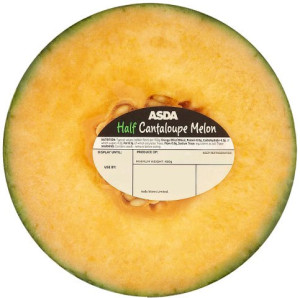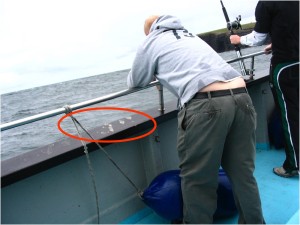In 1998, the U.S. Department of Agriculture very publicly began to urge consumers to use an accurate food thermometer when cooking ground beef patties because research demonstrated that the color of meat is not a reliable indicator of safety.
 USDA Under Secretary for Food Safety at the time, Catherine Woteki, said, “Consumers need to know that the only way to be sure a ground beef patty is cooked to a high enough temperature to destroy any harmful bacteria that may be present is to use a thermometer.”
USDA Under Secretary for Food Safety at the time, Catherine Woteki, said, “Consumers need to know that the only way to be sure a ground beef patty is cooked to a high enough temperature to destroy any harmful bacteria that may be present is to use a thermometer.”
At the time, I said, no one uses a meat thermometer to check the doneness of hamburgers. The idea of picking up a hamburger patty with tongs and inserting the thermometer in sideways was too much effort (others insist the best way to use a tip sensitive digital thermometer is to insert into the middle of the patty at a 45 degree angle).
Shortly thereafter, I started doing it and discovered, not only was using a meat thermometer fairly easy, it made me a better cook. No more burgers resembling hockey pucks, overcooked to ensure dangerous pathogens were gone. They tasted better.
By May 2000, USDA launched a national consumer campaign to promote the use of food thermometers in the home. The campaign featured an infantile mascot called Thermy who proclaimed, “It’s Safe to Bite When the Temperature is Right.”
Almost two decades later and I have the fervor of a born-again thermometerist, distributing them to friends, one meal at a time.
Sometime in the mid-2000s, in light of on-going outbreaks involving cantaloupe (rock melon) USDA started recommending that consumers wash the exterior to prevent dangerous microorganisms on the surface of the cantaloupe from coming into contact with the inner flesh.
I was not convinced.
And remain unconvinced (see video, below, from 2009).
 What is important that as soon as cantaloupe is chopped or cut in half, it needs to be kept cold (which is why it is disconcerting at markets and megalomarts in Australia and elsewhere to see melons sliced in half, wrapped in plastic and sitting at ambient temperature, which can be a tad warm in Brisbane).
What is important that as soon as cantaloupe is chopped or cut in half, it needs to be kept cold (which is why it is disconcerting at markets and megalomarts in Australia and elsewhere to see melons sliced in half, wrapped in plastic and sitting at ambient temperature, which can be a tad warm in Brisbane).
A new study compared two cantaloupe cutting methods and concluded that it’s best to limit contact with pathogens on the farm.
Whole and cut cantaloupes have been implicated as vehicles in foodborne illness outbreaks of norovirus, salmonellosis, and listeriosis. Preparation methods that minimize pathogen transfer from external surfaces to the edible tissue are needed.
Two preparation methods were compared for the transfer of Listeria monocytogenes, Salmonella enterica serovar Typhimurium LT2, murine norovirus, and Tulane virus from inoculated cantaloupe rinds to edible tissueand preparation surfaces.
For the first method, cantaloupes were cut into eighths, and edible tissue was separated from the rind and cubed with the same knife used to open the cantaloupes. For the second method, cantaloupes were scored with a knife around the circumference sufficient to allow manual separation of the cantaloupes into halves. Edible tissue was scooped with a spoon and did not contact the preparation surface touched by the rind. Bacteria and virus were recovered from the rinds, preparation surfaces, and edible tissue and enumerated by culture methods and reverse transcription, quantitative PCR, respectively. Standard plate counts were determined throughout refrigerated storage of cantaloupe tissue.
Cut method 2 yielded approximately 1 log lower recovery of L. monocytogenes and Salmonella Typhimurium from edible tissue, depending on the medium in which the bacteria were inoculated. A slight reduction was observed in murine norovirus recovered from edible tissue by cut method 2. The Tulane virus was detected in approximately half of the sampled cantaloupe tissue and only at very low levels. Aerobic mesophilic colony counts were lower through day 6 of storage for buffered peptone water–inoculated cantaloupes prepared by cut method 2. No differences were observed in environmental contamination as a function of cutting method.
Although small reductions in contamination of edible tissue were observed for cut method 2, the extent of microbial transfer underscores the importance of preventing contamination of whole cantaloupes.
Transfer of pathogens from cantaloupe rind to preparation surfaces and edible tissue as a function of cutting method
Journal of Food Protection®, Number 5, May 2016, pp. 696-889, pp. 764-770(7)
Shearer, Adrienne E. H.; LeStrange, Kyle; Castañeda Saldaña, Rafael; Kniel, Kalmia E.
http://www.ingentaconnect.com/contentone/iafp/jfp/2016/00000079/00000005/art00010










